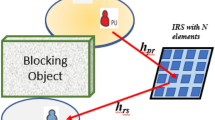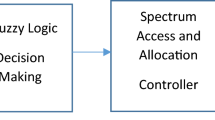Abstract
Spectrum sensing is the fundamental task for Cognitive Radio (CR). To overcome the challenge of high sampling rate in traditional spectral estimation methods, Compressed Sensing (CS) theory is developed. A sparsity and compression ratio joint adjustment algorithm for compressed spectrum sensing in CR network is investigated, with the hypothesis that the sparsity level is unknown as priori knowledge at CR terminals. As perfect spectrum reconstruction is not necessarily required during spectrum detection process, the proposed algorithm only performs a rough estimate of sparsity level. Meanwhile, in order to further reduce the sensing measurement, different compression ratios for CR terminals with varying Signal-to-Noise Ratio (SNR) are considered. The proposed algorithm, which optimizes the compression ratio as well as the estimated sparsity level, can greatly reduce the sensing measurement without degrading the detection performance. It also requires less steps of iteration for convergence. Corroborating simulation results are presented to testify the effectiveness of the proposed algorithm for collaborative spectrum sensing.
Similar content being viewed by others
References
J. Mitola III and G. Q. Maguire, Jr. Cognitive radio: Making software radios more personal. IEEE Personal Communications, 6(1999)4, 13–18.
S. Haykin. Cognitive radio: brain-empowered wireless communications. IEEE Journal on Selected Areas in Communications, 23(2005)2, 201–220.
Q. Zhao and B. M. Sadler. A survey of dynamic spectrum access. IEEE Signal Processing Magazine, 24(2007)3, 79–89.
D. L. Donoho. Compressed sensing. IEEE Transactions on Information Theory, 52(2006)4, 1289–1306.
Fanzi Zeng, Zhi Tian, and Chen Li. Distributed compressive wideband spectrum sensing in cooperative multi-hop cognitive networks. IEEE International Conference on Communications, Cape Town, South Africa, May 2010, 1–5.
Fanzi Zeng, Chen Li, and Zhi Tian. Distributed compressive spectrum sensing in cooperative multihop cognitive networks. IEEE Journal of Selected Topics in Signal Processing, 5(2011)1, 37–48.
Yang Lu, Wenbin Guo, Xing Wang, et al.. Distributed streaming compressive spectrum sensing for wide-band cognitive radio networks. 2011 IEEE 73rd Vehicular Technology Conference, Budapest, Hungary, May 2011, 1–5.
Bin Gu and Zhen Yang. Cooperative compressed sensing for wideband spectrum detection with sequential measurement. IEEE 12th International Conference on Communication Technology, Nanjing, China, Nov. 2010, 91–95.
Jason N. Laska, Sami Kirolos, Marco F. Duarte, et al.. Theory and implementation of an analog-to-information converter using random demodulations. IEEE International Symposium on Circuits and Systems, New Orleans, USA, May 2007, 1959–1962.
Di Zhang, Zhiyong Feng, Zaili Wang, et al.. A novel compressive ratio allocation method for collaborative wideband spectrum sensing. IEEE 9th Consumer Communications and Networking Conference, Las Vegas, NV, USA, Jan. 2012, 807–811.
Xing Wang, Wenbin Guo, Yang Lu, et al.. Adaptive compressive sampling for wideband signals. 2011 73rd Vehicular Technology Conference, Budapest, Hungary, May 2011, 1–5.
Steven Hong. Direct spectrum sensing from compressed measurements. Military Communications Conference, San Jose, California, USA, Oct. 2010, 1187–1192.
Marco F. Duarte, Shriram Sarvotham, Dror Baron, et al.. Distributed compressed sensing of jointly sparse signals. Conference Record of the 39th Asilomar Conference on Signals, Systems and Computers, Pacific Grove, CA, Oct. 2005, 1537–1541.
Jin Jian, Gu Yuantao, and Mei Shunliang. Journal of Electronics & Information Technology, 32(2010)2, 470–474 (in Chinese). 金坚, 谷源涛, 梅顺良. 压缩采样技术及其应用. 电子与信息学报, 32(2010)2, 470–474.
Zhi Quan, Shuguang Cui, H. Poor, et al.. Collaborative wideband sensing for cognitive radios. IEEE Signal Processing Magazine, 25(2008)6, 60–73.
Author information
Authors and Affiliations
Corresponding author
Additional information
Supported by the National Natural Science Foundation of China (No. 61102066), China Postdoctoral Science Foundation (No. 2012M511365), and the Scientific Research Project of Zhejiang Provincial Education Department (No. Y201119890).
Communication author: Xu Xiaorong, born in 1982, male, Postdoctor.
About this article
Cite this article
Chi, J., Zhang, J. & Xu, X. A sparsity and compression ratio joint adjustment method for collaborative spectrum sensing. J. Electron.(China) 29, 604–610 (2012). https://doi.org/10.1007/s11767-012-0906-8
Received:
Revised:
Published:
Issue Date:
DOI: https://doi.org/10.1007/s11767-012-0906-8




